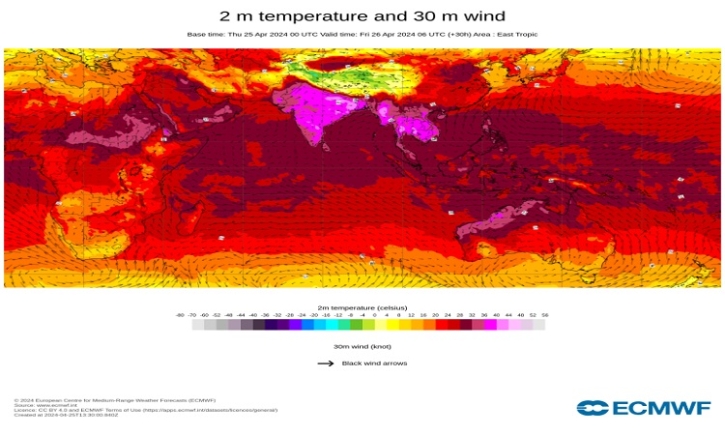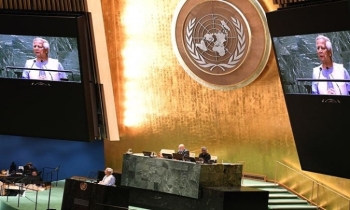Widespread parts of Asia and Africa reel under extreme weather: WMO
BI Report || BusinessInsider

Photo: WMO
Intense heat has gripped large parts of Asia, disrupting daily life and posing a serious health threat, the World Meteorological Organisation (WMO) said on Friday.
Besides, extreme rainfall and floods have claimed many lives and caused economic and agricultural losses in East Africa and parts of the Arabian peninsular.
The high-impact weather in the second half of April underlines yet again the vulnerability of society to weather, water and climate-related hazards and the need for Early Warnings For All.
The waning El Niño event, alongside a phenomenon known as the Indian Ocean Dipole, is playing a role, notably in the floods in East Africa and drought in Southern Africa and high temperatures in South East Asia.
But the excess energy trapped in the atmosphere and ocean by human-induced greenhouse gases is also having a major influence, especially on extreme heat, according to WMO experts.
“Climate change is exacerbating the frequency and severity of such events, profoundly impacting societies, economies, and, most importantly, human lives and the environment that we live in,” WMO Deputy Secretary-General Ko Barrett told the 80th session of the Economic and Social Commission for Asia and the Pacific on 23 April.
Ko Barrett highlighted how the extreme weather so far in 2024 in Asia continues the trends which were reported in the WMO State of the Climate in Asia 2023 report.
This showed that Asia remains the world’s most disaster-hit region from weather, climate and water-related hazards in 2023.
Floods and storms caused the highest number of reported casualties and economic losses, whilst the impact of heatwaves became more severe.
“Extreme heat is increasingly becoming the big silent killer,” said Ko Barrett.
“Heat-related mortality is widely under-reported and so the true scale of premature deaths and economic costs – in terms of reduced labour productivity, agricultural losses, and stress on the power grid - is not accurately reflected in the statistics,” she said.
Heat in Asia
The Intergovernmental Panel on Climate Change latest Assessment Report found that "In Asia, heat extremes have increased while cold extremes have decreased, and these trends will continue over the coming decades (high confidence)."
Last year, a World Weather Attribution study found that the “extreme humid heat in South Asia in April 2023, was largely driven by climate change, detrimental to vulnerable and disadvantaged communities.”
India has been experiencing heatwaves in recent weeks during the hot pre-monsoon period, with temperatures in the mid 40 °C’s. This is likely to continue, according to the Indian Meteorological Department.
"During March-May 2024, above-normal number of heatwave days are likely over most parts of the country except over Northeast India, Western Himalayan Region, Southwest Peninsula and West coast," said the Indian Meteorological Department.
“The frequency of heatwaves, their duration and their maximum duration are increasing, which is attributed to global warming. In the heat wave areas of India, the total duration of heat waves has increased by about 3 days in the last 30 years. The IPCC model projections indicate an increase of about two heat waves and heat wave duration by 12-18 days by 2060,” according to the Indian Meteorological Department.
India is successfully rolling out integrated heat-health forecasts action plans and #BeatTheHeat campaigns, with practical advice and information. But the vulnerable – including outdoor workers and those living in densely populated informal housing settlement are exposed.
Bangladesh, Myanmar and Thailand are among the other countries impacted, with schools closed and disruption to economic and agricultural activities.
April is typically a hotter month in the South Asia and Southeast Asia regions, but El Niño and climate change are driving temperatures to precariously high levels, says Ben Churchill, WMO Regional Director for Asia and the Southwest Pacific.
In Thailand’s capital Bangkok, the city’s environmental department issued a warning of extremely dangerous “feels like” heat levels (temperature and humidity).
It urged people to avoid heavy labor or exercise outdoors and recommended vulnerable members of the community to stay inside and keep hydrated. North of the capital, in Lampang province, the temperature reached 44.2° C, which is just short of the record 44.6° C registered last year.
Thailand’s health ministry reported on Wednesday that 30 heat-related deaths have been recorded since the start of this year, which is just short of the 37 total heatstroke deaths that were reported in all of 2023.
In neighboring Myanmar, the temperature has soared to 45.9° C during the week and the very hot conditions are expected to continue for several days.
Africa
Heavy seasonal rainfall has caused devastation throughout the East African region.
El Niño may be playing a role. The current positive Indian Ocean Dipole, influenced by record warm ocean temperatures in the north-west Indian Ocean might have influenced the extreme rainfall, according to WMO climate expert Alvaro Silva. Other climate factors may also be at play, he said.
In the United Republic of Tanzania, Prime Minister Kassim Majaliwa told Parliament that at least 155 people were reported killed and more than 230 injured by flash floods on 25 April. Neighboring Burundi also suffered casualties.
The WMO Regional Climate Centre for the Great Horn of Africa, known as ICPAC, forecasted exceptional rainfall for 23-30 April period in parts of the region, including northern and western Kenya, central and southern Ethiopia, southern Somalia and Djibouti, and northern and southern Uganda. It warned of flooding in the flood-prone areas.
In Kenya, the weather station of Kianamu (northeast of Nairobi), recorded about 120 mm of rain on 24 April.
The Kenya Meteorological Department issued a warning for the continuation of heavy rainfall at least until 28 April in many regions, including the Lake Victoria Basin, the Rift Valley, Highlands West and East of the Rift Valley, Southeast Lowlands, coast and northern sector is expected to continue from 25th April, 2024.
In southern Africa, the ongoing severe drought is due to a very poor rainy season (November to March), in line with the typical influence of El Niño in this region and further exacerbated by the exceptionally high temperatures, according to Alvaro Silva.
























